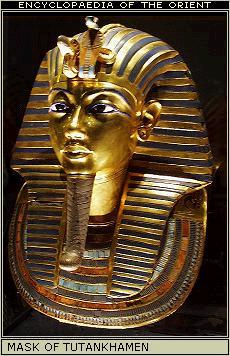 |
 |
 |
 |
 |
|
The 18th dynasty was the height of the might and glory of the Egyptan empire. Egypt controlled most
of Africa, including as far south as Nubia, the Middle East and Western Asia. This brought untold wealth and prosperity into
the empire. Among the pharaohs ruling during this time was Amenhotep III. His chief wife was Queen Tiy.
Tiy gave birth to at least two sons, Tuthmoses V and Amenhotep IV. Tuthmoses V, the first born and heir apparent to
the throne, died prematurely of unknown cause. This left Amenhotep IV as the successor to the throne of Egypt.
(Montserrat 64) As to when Amenhotep IV ascended to the throne is a cause of some controversy. There are two schools
of thought: One claims that Amenhotep became Pharaoh after the death of his father while others claim Amenhotep IV was Co-Regent
with his father during the last part of his father's life. Either way, Amenhotep IV's rule began in around year 1350 BC and
lasted 17 years until 1333 BC. The first few years of Amenhotep's reign was rather unremarkable. Like his father,
Amenhotep married a woman who was of a non-royal bloodline. His wife in many respects has eclipsed her husband's own
fame for her beauty. Queen Nefertiti, Amenhotep's chief wife, has often been cited as the most beautiful woman to have
ever lived, as a result of her stunning bust which is on display in a Museum in Berlin. (Freed 24)
|
|
 |
 |
 |
 |
|
 |
|
| Courtesy .womenintheancientworld.com/nefertiti.htm |
|
|
| The bust of Nefertiti is located at the Museum of Berlin. |
Nefertiti was the daughter of Ay who is believed to be the brother
of Queen Tiy. Together, they had six known daughters, one of which Ankhesenpaaten, became Queen of Amenhotep's successor
Tutankhamen. (Tyldesley 16) At the time of Amenhotep's reign and for all the remaining history of egypt, the empire;s
religion was polytheistic, having a vast number of deities. The dominant god at the time of Amenhotep's reign was the
god Amun or Amen.The success of Egyptian conquest during
the 18th dynasty was primarily ascribed to the god Amen. (Freed 88) As a result the fruits of conquest found their way
to the priests and the temple of Amen located at Karnak. Soon after becoming Pharaoh, Amenhotep IV set into motion a
course of events that drastically changed every aspect of life during his time. his first step was to change the style
of art. Previous art was very stylized representing the King in a very idealistic way. (Brovarski) Amenhotep IV's
reign bore witness to a shift from the idealistic art of his predecessors to that of more realism.
In around the fourth year of his reign, he began to reintroduce into prominence the
god Aten or Aton. The Aten had achieved great popularity during the first few dynasties but had slowly in popularity
through the various dynasties. During this same time, the King officially changed his name from Amenhotep, meaning Amen
is pleased, to the now infamous name of Akhenaten, also known as Akhnaton, Ikhnaton, Akhenaton, etc..., which means Aton
is satisfied.(Freed 61)
| Worship of Aten (The Solar Disc) |

|
| courtesy http://www.touregypt.net/featurestories/aten.htm |
In around the fourth year of his reign, he began to reintroduce into prominence
the god Aten or Aton. The Aten had achieved great popularity during the first few dynasties but had slowly in popularity
through the various dynasties. During this same time, the King officially changed his name from Amenhotep, meaning Amen
is pleased, to the now infamous name of Akhenaten, also known as Akhnaton, Ikhnaton, Akhenaton, etc..., which means Aton
is satisfied. Around the fifth year of his reign, he officially changed the state religion from the worhip of many
gods to the sole worship of the Aten and forbade the worship of other gods.
| Arial view of Capital City Akhetaten |
|
|
| courtesy http://touregypt.net/featurestories/amarna.htm |
This is the first recorded instance of Monotheism in history. In fact, Akhenaten went a step further than just
outlawing the worship of other gods, Akhenaten attempted to erase all memory of the other gods, especially Amen. The
effects of this decision are still visible to this day as the names of the gods' on many temples and Inscriptions have been
removed or scratched out. He even began to change many aspects of the written language, altering the spelling of the
word mother for example so that it would no longer make reference to the Deity of the same name. (Freed 88) In the sixth
or seventh year of his reign, Akhenaten began construction on a new Capital called Akhetaten, which is now modern day Tel
el-Amarna. the new capital was located quite a distance north of the former.

As previously mentioned Akhenaten's reign lasted 17 years. It is believed that Akhenaten died
in the city he built but this cannot be confirmed. After his reign the famous king Tutankhamen was his successor. It is believed
that Tutankhamen was in all likely hood a close relative perhaps brother or even son of Akhenaten. In fact Tutankhamen's name
prior to becoming king was Tutankhaten. During this time the capital was moved back Thebes, the old artistic style and religion
was restored. Once the previous order was restored a concerted effort was made to eliminate all traces of this heretic king.
In fact such a good job was done supressing knowlege of the heretic king that little was known about Akhenaten until the 19th
century.
 |